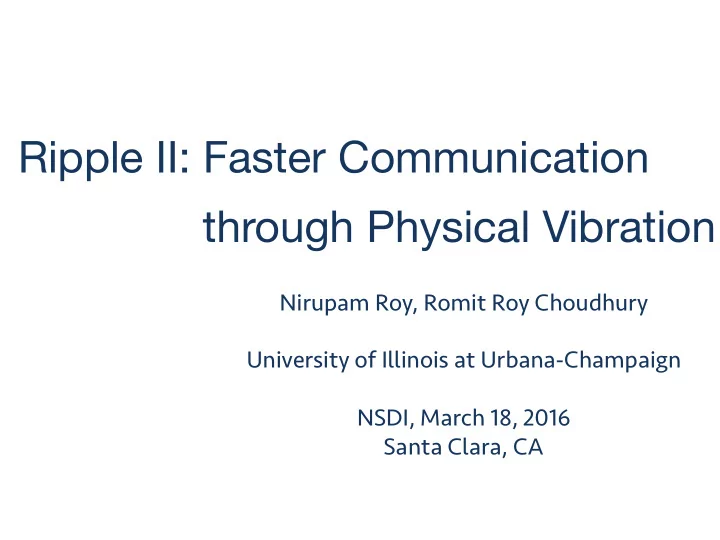

Ripple II: Faster Communication through Physical Vibration Nirupam Roy, Romit Roy Choudhury University of Illinois at Urbana-Champaign NSDI, March 18, 2016 Santa Clara, CA
Short range communication: a new need of this decade
Short range communication: a new need of this decade
Emerging technologies for short range Convenience � Availability � Security / Privacy � Health � Capacity � Energy � Driving forces of short range communication research
Emerging technologies for short range Visible Light Communication � Acoustic NFC �
Physical vibration: a new mode of communication
Physical vibration: a new mode of communication Vibration Motor Accelerometer
Physical vibration: a new mode of communication Vibration Motor Accelerometer
Ripple: vibratory communication Application Vibratory Radio 6 bps 80 bps 200 bps 400 bps +secured Morse-code Single-Carrier Multi-Carrier Spatial channels Phy-Security Hardware
Search for a better Ripple 0.2K Ripple - I 0.3K Ultrasound 1.0K Visible Light 9.6K Infrared 32K Ripple - II 106K NFC (bits-per-second, entry level versions)
Hardware front-end Vibration recovery at the receiver Transmitter side rate control
Hardware front-end Vibration recovery at the receiver Transmitter side rate control
A better sensor for physical vibration The transmitter: Driving voltage
A better sensor for physical vibration The receiver: Amplitude Accelerometer Frequency Vibration 1K 5K 10K 15K Amplitude Microphone + - Vibration + Sound Frequency 1K 5K 10K 15K
A better sensor for physical vibration The receiver: Amplitude Accelerometer Frequency Vibration 1K 5K 10K 15K OFDM Amplitude Microphone + - Vibration + Sound Frequency 1K 5K 10K 15K
A better sensor for physical vibration The receiver: OFDM But wait… Amplitude Microphone + - Vibration + Sound Frequency 1K 5K 10K 15K
A better sensor for physical vibration The receiver: Ambient sound OFDM Amplitude Microphone + - Vibration + Sound Frequency 1K 5K 10K 15K
Hardware front-end Vibration recovery at the receiver Transmitter side rate control
Vibration recovery at receiver Vibration Primary mic. V+S V - S V S S Sound Secondary mic.
Vibration recovery at receiver Vibration Primary mic. V+S V Adaptive S V Filter S” S” Sound Secondary mic.
Vibration recovery at receiver Vibration Primary mic. V+S V Adaptive S V” V Filter V”+ S” S” Sound Secondary mic.
Vibration recovery at receiver Vibration Primary mic. V+S V Adaptive S V” V Filter V”+ S” S” Sound Secondary mic. Signal sources are correlated
Vibration recovery at receiver Vibration Primary mic. V+S V Adaptive Symbol Selective Adaptive Filtering S V” V Filter V”+ S” S” Sound Secondary mic. Signal sources are correlated
Vibration recovery at receiver Noise is sparse in frequency Static channel between the sensors Primary mic. Ambient sound Amplitude H Vibration frequency bins Secondary mic. Frequency
Vibration recovery at receiver Static channel between the sensors Amplitude Primary mic. Frequency Relative estimate of the channel H Amplitude Secondary mic. Frequency
Vibration recovery at receiver Selected bins (primary mic.) Adaptive Filter Corrected bins Selected bins (secondary mic.)
Hardware front-end Vibration recovery at the receiver Transmitter side rate control
MAC layer rate control 1 Transmitter side Packet 02 Symbol 07 Symbol 06 Symbol 05 Symbol 04 Symbol 03 Packet 01 Symbol 02 Symbol 01 Receiver side
MAC layer rate control ACK 2 Packet 02 Packet 01 Transmitter Receiver side side Symbol 06 Symbol 05 Symbol 04 Symbol 03 Symbol 07 Symbol 02 Symbol 01 Interference sensing
MAC layer rate control ACK Packet 02 Packet 01 Transmitter Receiver side side Symbol 06 Symbol 05 Symbol 04 Symbol 03 Symbol 07 Symbol 02 Symbol 01 Interference sensing
MAC layer rate control Back-EMF
MAC layer rate control Symbol 01 “Listening through a Vibration Motor” Nirupam Roy, Romit Roy Choudhury [MobiSys 2016] Back-EMF
MAC layer rate control Back-EMF
MAC layer rate control Low “Signal to Interference and Noise Ratio” (SINR) Symbol 06 Symbol 04 Symbol 05 Symbol 03 Symbol 02 Symbol 07 Symbol 01 OFDM symbols
MAC layer rate control Symbol 07 Symbol 06 OFDM symbols Symbol 05 Symbol 04 Symbol 03 Symbol 02 Symbol 01 Corrupted symbols Symbol 06 Symbol 05 Symbol 02
MAC layer rate control Symbol 07 Symbol 06 OFDM symbols Symbol 05 Symbol 04 Symbol 03 Symbol 02 Symbol 01 Corrupted symbols Symbol 06 Symbol 05 Symbol 02 Symbol retransmission Symbol 09 Symbol 08 Symbol 06 Symbol 05 Symbol 02 Symbol 07
MAC layer rate control Symbol 07 How can the receiver detect a duplicate symbol? What is the data-rate of the duplicate symbol? Symbol 06 OFDM symbols Symbol 05 Symbol 04 Symbol 03 Symbol 02 Symbol 01 Corrupted symbols Symbol 06 Symbol 05 Symbol 02 Symbol retransmission Symbol 09 Symbol 08 Symbol 06 Symbol 05 Symbol 02 Symbol 07
MAC layer rate control Symbol 01 Half of the symbol per Doubles per bit energy Symb ol 01 retransmission Data in alternate frequency bins Identical halves in the time domain signal Algorithm detects this Schmidl-Cox special symbol at the sync. algo. receiver
Evaluation
Evaluation
Evaluation
Evaluation
Applications Vibrations do not tether � Vibrations do not broadcast � Vibratory communication �
Applications Communication through Touch activated smart-lock bone conduction � RECEIVE P2P money transfer
Thank You h6p://synrg.csl.illinois.edu/ripple/ (SyNRG Hardware Lab, UIUC)
Recommend
More recommend